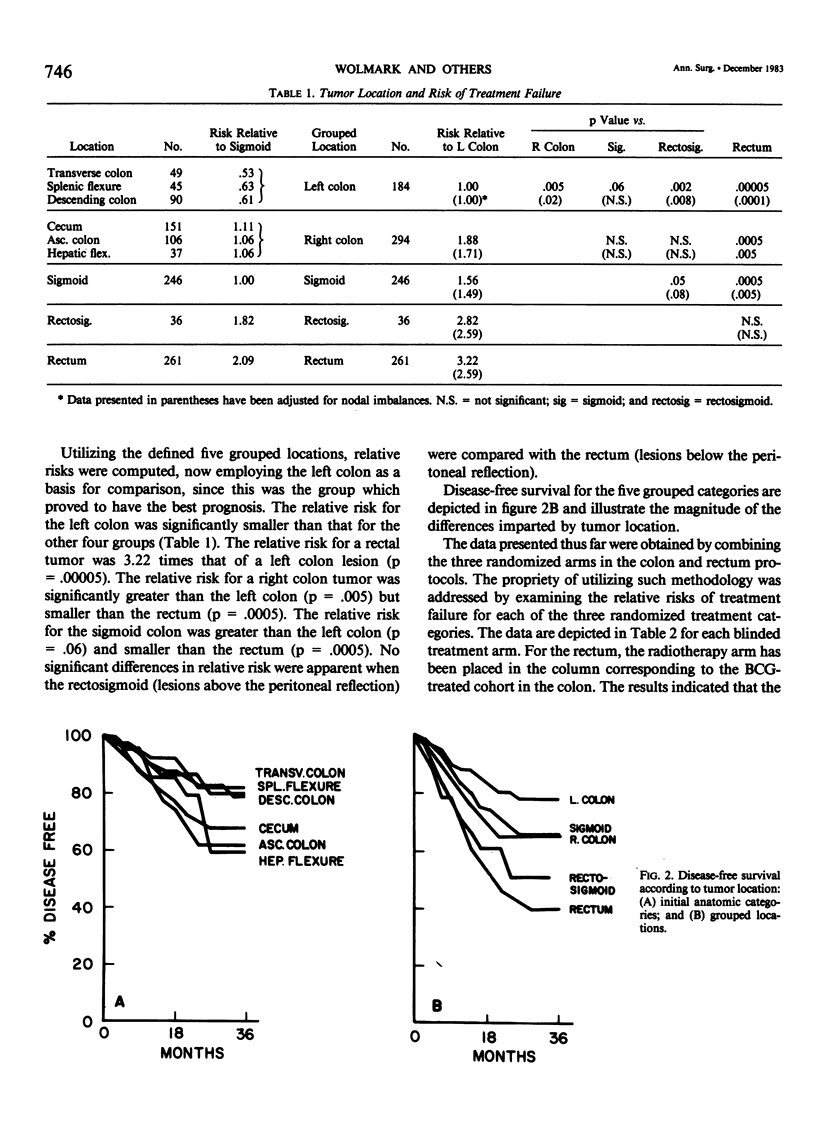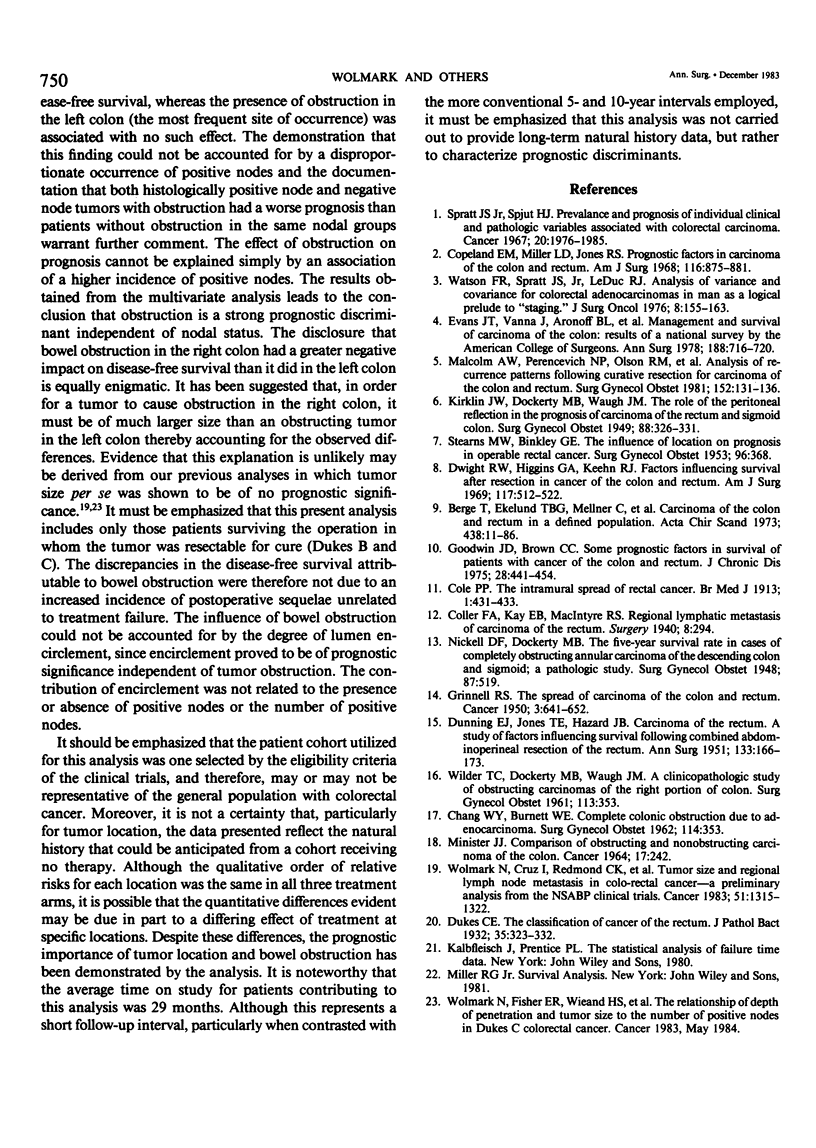Abstract
The present study examines the prognostic significance of tumor location and bowel obstruction in Dukes B and C colorectal cancer. Data were obtained from 1021 patients entered into two randomized prospective clinical trials of the NSABP. Tumor location proved to be a strong prognostic discriminant. Lesions located in the left colon demonstrated the most favorable prognosis. Tumors of the rectosigmoid and rectum had the worst prognosis with the relative risk of treatment failure for the latter being over three fold that of the left colon. When the relative risks associated with tumor location were adjusted for nodal imbalances, the left colon continued to demonstrate the most favorable prognosis. The presence of bowel obstruction also strongly influenced the prognostic outcome. Examination of the data without considering tumor location disclosed that patients with bowel obstruction were at greater risk for treatment failure than those without obstruction. The effect of bowel obstruction was influenced by the location of the tumor. The occurrence of bowel obstruction in the right colon was associated with a significantly diminished disease-free survival, whereas obstruction in the left colon demonstrated no such effect. This phenomenon was independent of nodal status and tumor encirclement, the latter two factors proving to be of prognostic significance independent of tumor obstruction. A multivariate analysis in which the covariate effects of sex, age, nodal status, tumor obstruction, encirclement, and tumor location were adjusted underscored the role of tumor location and obstruction as prognostic discriminants. The results indicate that the definition of prognostic factors can identify patient subsets with unique characteristics.
Full text
PDF









Selected References
These references are in PubMed. This may not be the complete list of references from this article.
- Berge T., Ekelund G., Mellner C., Pihl B., Wenckert A. Carcinoma of the colon and rectum in a defined population. An epidemiological, clinical and postmortem investigation of colorectal carcinoma and coexisting benign polyps in Malmö, Sweden. Acta Chir Scand Suppl. 1973;438:1–86. [PubMed] [Google Scholar]
- CHANG W. Y., BURNETT W. E. Complete colonic obstruction due to adenocarcinoma. Surg Gynecol Obstet. 1962 Mar;114:353–356. [PubMed] [Google Scholar]
- Copeland E. M., Miller L. D., Jones R. S. Prognostic factors in carcinoma of the colon and rectum. Am J Surg. 1968 Dec;116(6):875–881. doi: 10.1016/0002-9610(68)90458-3. [DOI] [PubMed] [Google Scholar]
- DUNNING E. J., JONES T. E., HAZARD J. B. Carcinoma of the rectum; a study of factors influencing survival following combined abdominoperineal resection of the rectum. Ann Surg. 1951 Feb;133(2):166–173. doi: 10.1097/00000658-195102000-00003. [DOI] [PMC free article] [PubMed] [Google Scholar]
- Dwight R. W., Higgins G. A., Keehn R. J. Factors influencing survival after resection in cancer of the colon and rectum. Am J Surg. 1969 Apr;117(4):512–522. doi: 10.1016/0002-9610(69)90010-5. [DOI] [PubMed] [Google Scholar]
- Evans J. T., Vana J., Aronoff B. L., Baker H. W., Murphy G. P. Management and survival of carcinoma of the colon: results of a national survey by the American College of Surgeons. Ann Surg. 1978 Dec;188(6):716–720. doi: 10.1097/00000658-197812000-00002. [DOI] [PMC free article] [PubMed] [Google Scholar]
- GRINNELL R. S. The spread of carcinoma of the colon and rectum. Cancer. 1950 Jul;3(4):641–652. doi: 10.1002/1097-0142(1950)3:4<641::aid-cncr2820030409>3.0.co;2-i. [DOI] [PubMed] [Google Scholar]
- Godwin J. D., 2nd, Brown C. C. Some prognostic factors in survival of patients with cancer of the colon and rectum. J Chronic Dis. 1975 Oct;28(9):441–454. doi: 10.1016/0021-9681(75)90055-7. [DOI] [PubMed] [Google Scholar]
- MINSTER J. J. COMPARISON OF OBSTRUCTING AND NONOBSTRUCTING CARCINOMA OF THE COLON. Cancer. 1964 Feb;17:242–247. doi: 10.1002/1097-0142(196402)17:2<242::aid-cncr2820170214>3.0.co;2-m. [DOI] [PubMed] [Google Scholar]
- Malcolm A. W., Perencevich N. P., Olson R. M., Hanley J. A., Chaffey J. T., Wilson R. E. Analysis of recurrence patterns following curative resection for carcinoma of the colon and rectum. Surg Gynecol Obstet. 1981 Feb;152(2):131–136. [PubMed] [Google Scholar]
- STEARNS M. W., Jr, BINKLEY G. E. The influence of location on prognosis in operable rectal cancer. Surg Gynecol Obstet. 1953 Mar;96(3):368–370. [PubMed] [Google Scholar]
- Spratt J. S., Jr, Spjut H. J. Prevalence and prognosis of individual clinical and pathologic variables associated with colorectal carcinoma. Cancer. 1967 Nov;20(11):1976–1985. doi: 10.1002/1097-0142(196711)20:11<1976::aid-cncr2820201125>3.0.co;2-m. [DOI] [PubMed] [Google Scholar]
- WILDER T. C., DOCKERTY M. B., WAUGH J. M. A clinicopathologic study of obstructing carcinomas of the right portion of the colon. Surg Gynecol Obstet. 1961 Sep;113:353–359. [PubMed] [Google Scholar]
- Watson F. R., Spratt J. S., Jr, LeDuc R. J. Analysis of variance and covariance for colorectal adenocarcinomas in man as a logical prelude to "staging". J Surg Oncol. 1976;8(2):155–163. doi: 10.1002/jso.2930080211. [DOI] [PubMed] [Google Scholar]
- Wolmark N., Cruz I., Redmond C. K., Fisher B., Fisher E. R. Tumor size and regional lymph node metastasis in colorectal cancer. A preliminary analysis from the NSABP clinical trials. Cancer. 1983 Apr 1;51(7):1315–1322. doi: 10.1002/1097-0142(19830401)51:7<1315::aid-cncr2820510723>3.0.co;2-0. [DOI] [PubMed] [Google Scholar]


